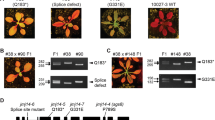Abstract.
Linked and unlinked copies of transgenes and related endogenous genes in plants can be epigenetically silenced by homology-based mechanisms that operate at either the transcriptional or post-transcriptional level. Transcriptional inactivation is associated with promoter homology and meiotically heritable methylation. Post-transcriptional silencing requires homology in protein-coding regions and is fully reversed during meiosis. Recently, the notion that both of these processes reflect the action of different host defence systems has been strengthened: (i) Obvious parallels have emerged between promoter homology-dependent silencing/methylation of transgenes and paramutation of endogenous genes that contain transposable elements in their promoters; (ii) remarkable similarities have been observed between post-transcriptional silencing involving transgenes and natural forms of virus resistance in nontransgenic plants. These results and others implicate two distinct cellular defence responses in transgene silencing. One is active in the nucleus and is manifested by transgene methylation, a reaction that might have originated as a means to oppose the spread of transposable elements. A second line of defence resides in the cytoplasm and operates through enhanced RNA turnover, a process that might help plants overcome viral infection.
Similar content being viewed by others
Author information
Authors and Affiliations
Rights and permissions
About this article
Cite this article
Matzke, M., Matzke, A. Epigenetic silencing of plant transgenes as a consequence of diverse cellular defence responses. CMLS, Cell. Mol. Life Sci. 54, 94–103 (1998). https://doi.org/10.1007/s000180050128
Issue Date:
DOI: https://doi.org/10.1007/s000180050128




